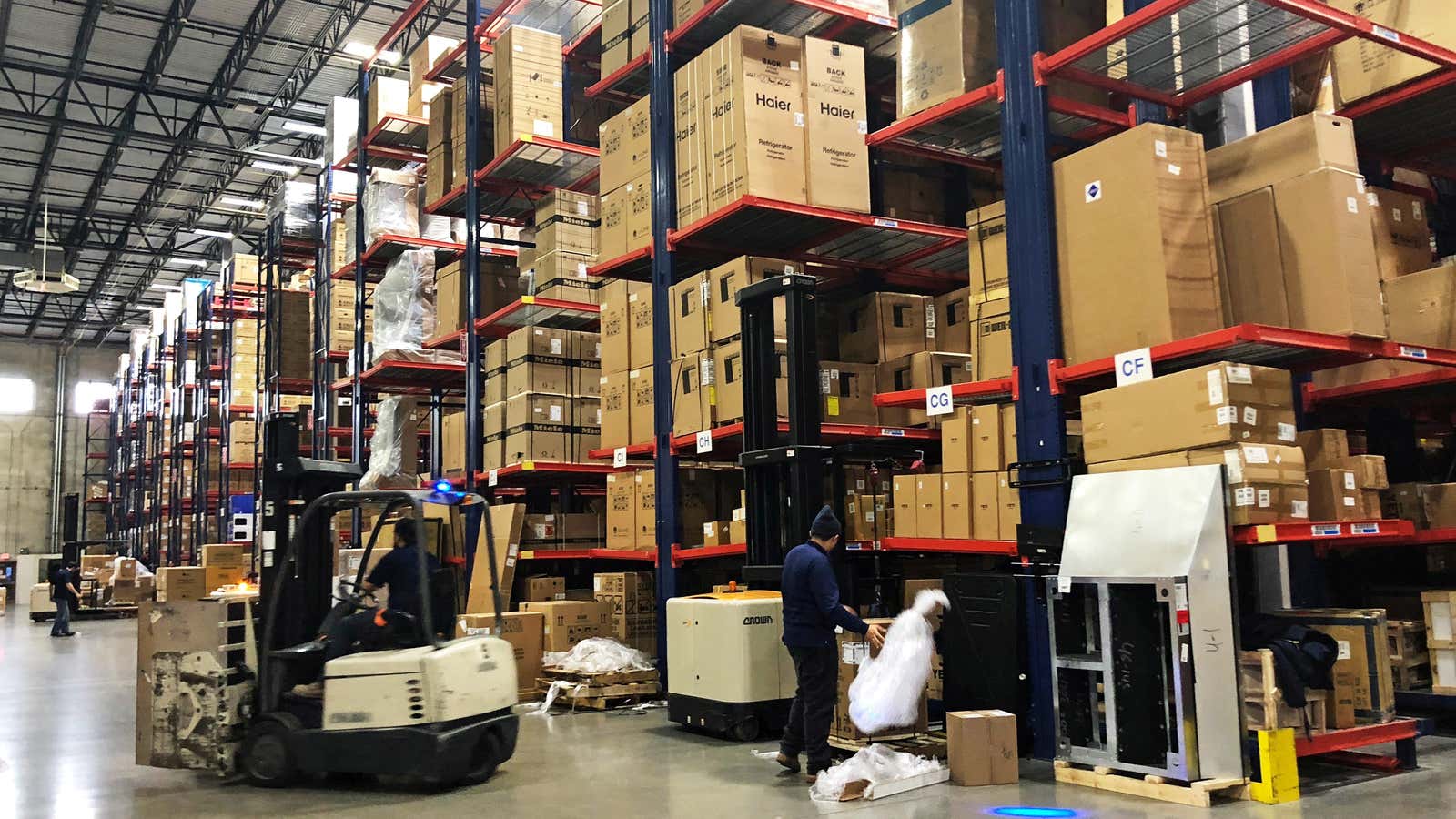In an ideal world, Dave Reilly would like his company United Solutions to have 45 days of inventory: 45 days’ worth of the hard plastic storage boxes, recycling bins, and utility buckets that it supplies to firms like Rubbermaid. Today, United Solutions holds fewer than 30 days’ worth—in large part, Reilly said, because he can’t find the workers to produce fresh stock.
Reilly, the CEO of the 100-year-old United Solutions, oversees a factory in Massachusetts and another in Mississippi, each with around 250 people employed on production lines. Business is booming, and Reilly is trying to fill at least 100 jobs in manufacturing and distribution. But for the kind of positions he’s trying to fill, he said—”machine operators, people who run the equipment, with some tech skills”—it’s been hard to hire new people. That’s why United Solutions’s production is about 25% short of what it needs, forcing it to dig into its inventory to supply its customers.
Manufacturers are drawing down product stocks
Other companies in the US are being forced to draw down their inventories as well. The US Census Bureau tracks business’ inventory-to-sales ratio across retail, wholesale and manufacturing sectors; a ratio of 1.5, for instance, indicates that inventory levels can meet 1.5 months’ worth of sales. When the pandemic hit last year, inventory levels soared, and the ratio neared 1.7. Now the ratio has dropped close to 1.2, the lowest in the past 30 years.
Labor crunches aside, there are multiple reasons for this plunge: supply bottlenecks, for instance, or sudden and strong consumer demand. As a result of all of these factors, companies are scrambling to meet demand—and if their production lines aren’t up to the task, they must turn to their stocks of inventory. In the first quarter of 2021, close to a third of the growth in domestic demand was met by running down inventories, the economists Jason Furman and Wilson Powell III found. They issued a cautionary note as well: Inventories “cannot be run down forever.”
In earnings calls, companies refer frequently to their inventory levels. In late May, a John Deere executive said that inventories for agricultural equipment “remain at historic lows” and added: “Furthermore, labor markets are extremely tight, delaying efforts to ramp up.” RBC Bearings, which manufactures ball-bearings and other components for aerospace and defense companies, acknowledged that some of its “key inventories” stood depleted, because both steel and labor are in short supply. (“We’re competing with our own government on labor,” Michael Hartnett, the company’s CEO, said, referring to the state’s generous unemployment relief program during the pandemic.) Hormel Foods, which makes Spam, cited a “difficult labor environment,” particularly in “boning capacity”: the manpower required to cut meat and prepare it for processing.
What happens if the labor market shortage is real and long-lasting?
Eventually, if these conditions extend into the future, production squeezes will result in price increases. The simplest of economics predicts that, after all: When the demand for a product is greater than its supply, the producers have the space to profitably hike their prices. Furman and Powell, the economists, forecast this as well. Fulfilling the surge in consumer demand, they wrote, “would require either the 10 million workers short of trend to get jobs extremely quickly, average hours to increase a lot, or productivity to jump up. Absent those changes, the result would be a substantial increase in prices—with prices rising more than a percentage point above their pre-pandemic trend.”
This is already happening further up the supply chain. In earnings calls, companies of all stripes are noting the higher cost of materials like lumber and steel—as well as the plastic resin United Solutions uses. As the bottlenecks and pent-up demand generated by the pandemic ease, these prices may yet subside, as many economists and US Federal Reserve officials believe. But among others, they are prompting fears of a more sustained bout of inflation.
At United Solutions, Reilly has tried to address the labor shortages in various ways. “We’ve increased our base labor rate by more than $2 per hour,” he said. The company offers bonuses to employees who brought a friend or a family member into the workforce. “It’s worked a little, but we’re still challenged,” Reilly said. The factories run almost 24/7, and Reilly’s managers and office staff are sometimes drafted to supervise the molding machinery. Reilly is also buying products from sub-contractors: other manufacturers of molded plastic products.
There are, as Reilly knows, several factors contributing to this crunch. One of them is a shortage of the plastic resin that United Solutions needs to make its storage containers—and that, in turn, is partly attributable to labor difficulties as well. Another kind of deficit that Reilly encounters is a lack of truck drivers, although this may be not so much a labor shortage as a wage shortage: a gap in the kind of compensation that long-haul truckers feel they deserve.
Reilly also thinks the generosity of unemployment benefits make people reluctant to apply for work. This connection isn’t necessarily a straightforward one. A number of studies last year found payments disbursed under the CARES Act did not have a significant effect on the labor supply.
But Reilly offers at least one piece of anecdotal observation. In Mississippi, the governor has announced that the state would opt out of the federal unemployment benefits program on June 12, rather than letting it run till September. That has changed things somewhat for his Mississippi plant, Reilly said, “because people know that if they want to work, they have to apply for jobs now, not wait around until the 12th. So we’re starting to see some interest—some uptick in people wanting to work with us.”
